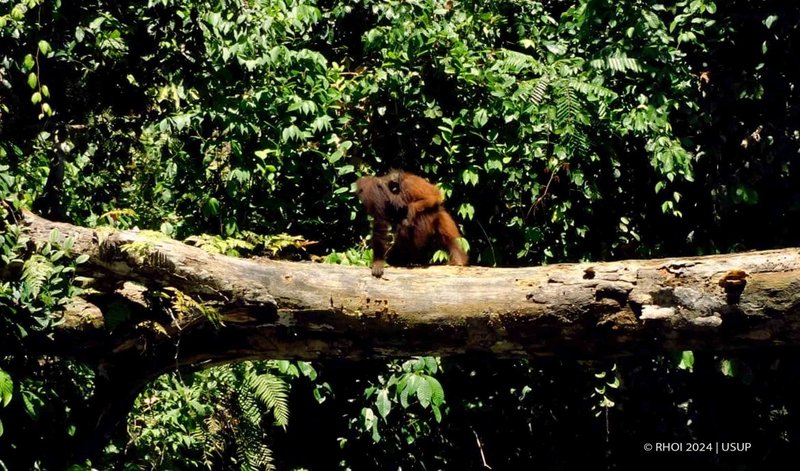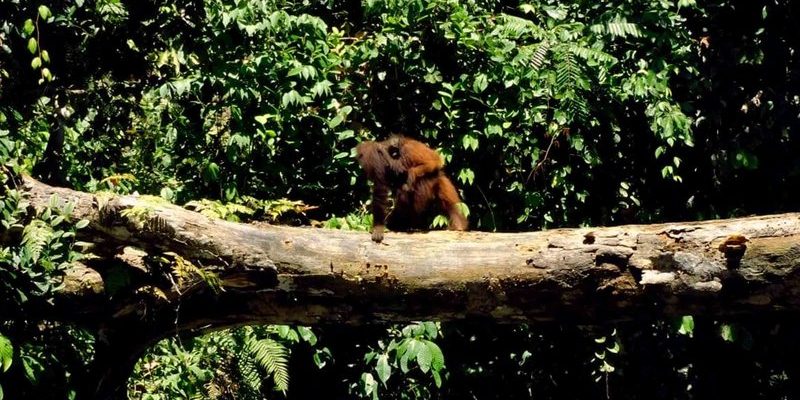
But how do they do it? Think of Sumatran orangutans as the ultimate survival experts of the jungle. They’ve got a toolbox of strategies to ensure they thrive, even when faced with obstacles like food scarcity and habitat loss. It’s like they’ve got their own set of survival skills, honed over years of evolution. Let’s dive into the remarkable ways these orangutans manage to live in such demanding conditions.
Physical Adaptations for Survival
Sumatran orangutans are built for their environment. Their long arms and strong shoulders allow them to swing from tree to tree, covering great lengths in search of food. This incredible physical adaptability helps them stay off the ground, where predators lurk.
They also have prehensile hands—think of them as having extra fingers! This special feature helps them grasp branches and climb with ease. When you see them gather fruit or pick leaves, it looks almost like they’re performing a delicate dance in the treetops. This ability isn’t just for show; it’s essential for feeding and staying safe.
Another adaptation worth mentioning is their thick fur, which protects them from the elements. In the humid climate of Sumatra, their hair helps regulate body temperature, keeping them cool when it’s hot and dry when it rains. Given these traits, it’s no surprise that these orangutans thrive even in potentially harsh conditions.
Food Sources and Dietary Flexibility
Here’s the thing: food isn’t always plentiful in the dense jungles. Sumatran orangutans are omnivores, which means they eat a variety of things. Their diet mainly consists of fruits, but they also munch on leaves, flowers, and insects. This varied diet allows them to adapt when certain foods aren’t available.
During fruiting seasons, you might find them feasting on ripe durians or mangosteens high up in the trees. But they don’t just wait around; they’ve learned to follow seasonal changes. When one food source runs low, they switch to another, showcasing their cleverness.
It’s almost like a mini survival plan—when life gives them lemons (or, in this case, a lack of fruit), they make lemonade by finding alternative options. This flexibility ensures they can sustain themselves even when conditions aren’t ideal.
Building Nests for Safety
Every night, Sumatran orangutans build nests to sleep in. These nests aren’t just for comfort; they play a crucial role in their survival. When dusk falls, they carefully weave together leaves and branches to create a cozy space high in the trees.
This nesting habit keeps them safe from predators like cats and snakes that roam the forest floor. It’s a bit like having a treehouse—safe, secluded, and perfect for a good night’s sleep. Interestingly, they usually prefer to build their nests in areas with abundant food sources nearby, so they can wake up and start the day ready to feast.
The nests are also a sign of their intelligence. Each orangutan has its own style, creating a unique sleeping spot that fits them perfectly. You might be wondering how they even manage this—well, they’ve learned over time from their mothers and peers.
Social Behavior and Learning
Sumatran orangutans are mostly solitary animals, but they’re not entirely alone. They have a unique social structure that helps them during tough times. Young orangutans stay with their mothers for several years, learning essential survival skills along the way, like foraging for food and building nests.
Here’s a fun fact: they communicate with each other using a variety of sounds. This vocalization helps them stay in touch even from a distance. Imagine having a friend you can shout to from the next tree! This social aspect can be crucial when they encounter challenges; sharing information can lead to better survival strategies.
Their ability to learn from one another and adapt their behaviors is crucial—especially in a changing environment. When faced with challenges like deforestation, these learnings can make the difference between thriving and merely surviving.
Dealing with Climate Challenges
Climate plays a significant role in the lives of Sumatran orangutans. They experience heavy rains, long dry spells, and even droughts. To cope, they change their behaviors. During periods of heavy rain, for instance, they may forage for food closer to their nests to avoid getting soaked.
In dry seasons, they’ve been known to travel longer distances to find water. It’s all about flexibility—adjusting their daily routines based on what Mother Nature throws at them. This adaptability is vital; without it, they wouldn’t be able to withstand the changing climate and its impact on their habitat.
You might also wonder how they deal with habitat loss due to human activities like logging and agriculture. It’s a significant challenge, but orangutans are resourceful. They’ve been observed altering their movement patterns and foraging strategies to adapt to fragmented habitats, showcasing their incredible resilience.
The Role of Conservation in Their Survival
Unfortunately, the survival of Sumatran orangutans isn’t just about their natural adaptations anymore; it’s also about human intervention. Conservation efforts play a vital role in their future. Organizations are working tirelessly to protect their habitats and create corridors that allow them to travel safely between areas.
These efforts are like a safety net, ensuring that orangutans can continue to thrive despite the challenges they face. When people work to preserve their environment, it’s not just about saving a species; it’s also about saving the intricate web of life that orangutans are a part of.
By advocating for sustainable practices and supporting conservation initiatives, everyone can contribute to the survival of these incredible creatures. It’s a reminder that our actions matter and that we’re all connected.
Sumatran orangutans are truly remarkable creatures, embodying resilience and adaptability in the face of harsh environmental challenges. From their physical adaptations to their intelligent nesting and social behaviors, they showcase the incredible ways life finds a way to endure. Their survival skills serve as a testament to nature’s ingenuity.
As we learn about their lives, it’s essential to remember our role in ensuring their future. Supporting conservation efforts and respecting their habitats can make a meaningful difference. Sumatran orangutans remind us that the wild is a delicate balance of survival, and every effort counts in keeping that balance intact. So, next time you think of these amazing primates, remember: they’re not just surviving; they’re thriving, and with our help, they can continue to do so.

